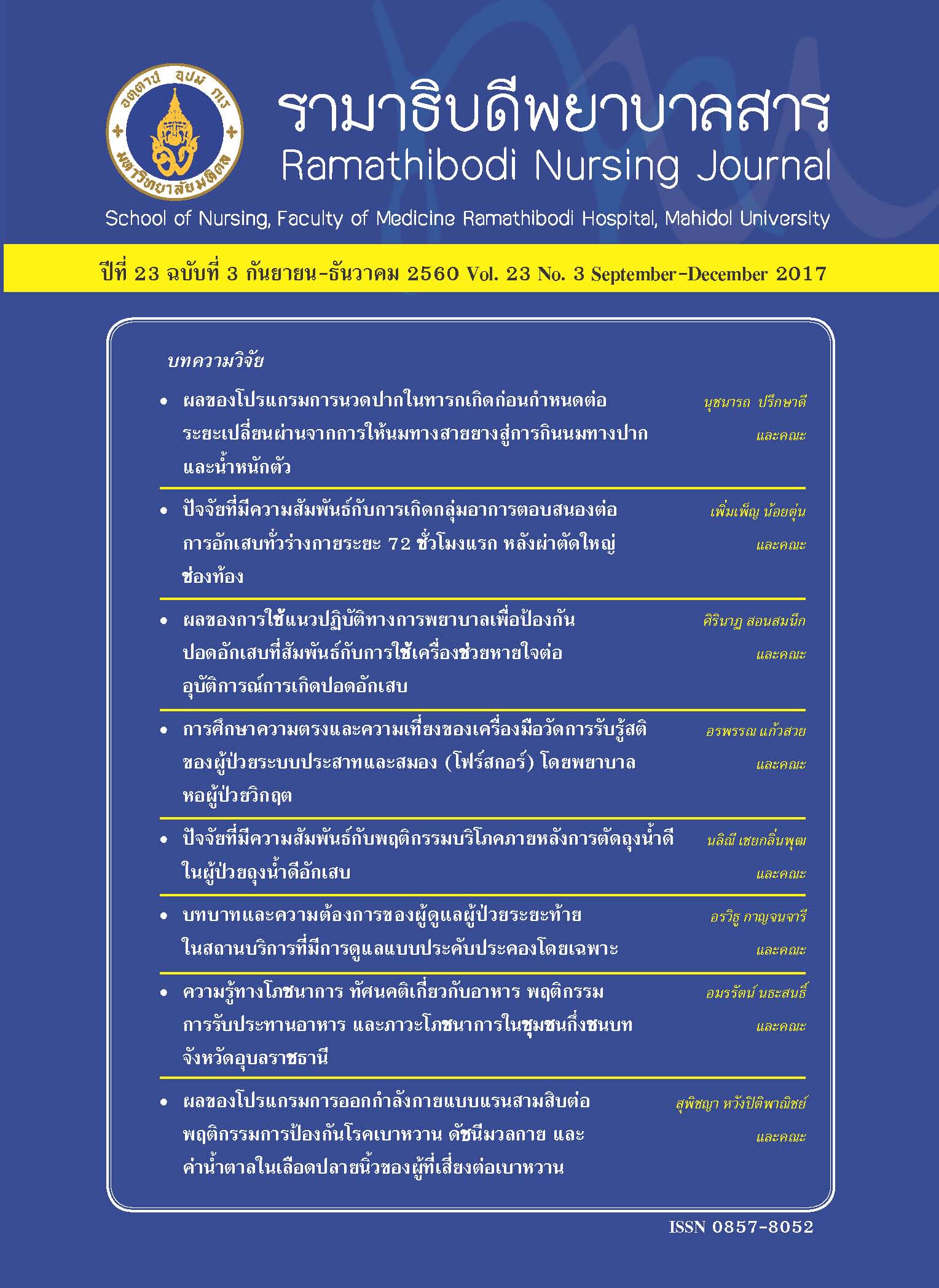Effect of the Premature Infant Oral Motor Intervention on Transition Time from Tube to Oral Feeding and Body Weight
Main Article Content
Abstract
Abstract
This present study was a quasi-experimental research based on a two-group post test design for the purpose of studying the effect of the Premature Infant Oral Motor Intervention (PIOMI) on the transition time from tube to oral feeding and weight gain. The sample consisted of 32 preterm infants with gestational age of 31 to 34 weeks who had been admitted to the neonatal intensive care unit (NICU) and high risk ward between August and November, 2015. The sample was selected by purposive sampling and randomly assigned to either the control group or the experimental group. Sixteen premature infants in the experimental group received PIOMI, while the other 16 in the control group received conventional nursing care. Data collection was performed by recording the infants’ weight and the date from beginning of independent oral feeding until the infant was able to complete all the 8 feedings per day for two consecutive days. Chi-square and independent t-test were used to analyze data regarding demographic characteristics. The transition time from tube to oral feeding and weight gain were analyzed using independent t-test. The study findings showed that premature infants who received PIOMI had a statistically significant shorter transition time from tube to oral feeding than those who received conventional nursing care. However, the mean weight gain per day of the subjects in both groups was not significantly different. Based on these findings, the PIOMI could be used as a nursing practice guideline to promote the development of sucking and swallowing skills in premature infants.
Keywords : Premature Infants, Oral stimulation, Body weight, Transition time from tube to oral feeding
Article Details
บทความ ข้อมูล เนื้อหา รูปภาพ ฯลฯ ที่ได้รับการตีพิมพ์ในรามาธิบดีพยาบาลสาร ถือเป็นลิขสิทธิ์ของวารสาร หากบุคคลหรือหน่วยงานใดต้องการนำทั้งหมดหรือส่วนหนึ่งส่วนใดไปเผยแพร่หรือเพื่อกระทำการใด ใด จะต้องได้รับอนุญาตเป็นลายลักษณ์อักษรจากรามาธิบดีพยาบาลสารก่อนเท่านั้น
References
2. Bureau of Policy and Strategy. Birth rate, death rate, and natural growth rate, 2011-2015; 2015 [cited 2016 January 14]. Available from Bureau of Policy and Strategy Website: http://www.bps.ops.moph.go.th/ healthinformation/index.(in Thai)
3. Burklow KA, McGrath AM, Valerius KS, Rudolph C. Relationship between feeding difficulties, medical complexity, and gestational age. Nutr Clin Pract. 2002;17(6):373-8.
4. Amaizu N, Shulman R, Schanler R, Lau C. Maturation of oral feeding skills in preterm infants. Acta Paediatr. 2008;97(1):61-7.
5. Barlow SM. Oral and respiratory control for preterm feeding. Curr Opin Otolaryngol Head Neck Surg.2009;17(3):179-86.
6. Mizuno K, Ueda A. The maturation and coordination of sucking, swallowing, and respiration in preterm infants. J Pediatr; 2003,142(1):36-40.
7. Vetchapard C, Palawiwat K. Physiology of exercise. 4th ed. Bangkok: Tepparat printing; 1985. (in Thai)
8. Pummipon C. Effect of suck-swallow stimulation program on readiness and effectiveness of nutrition sucking in preterm infants [thesis]. Chiang Mai, Chiang Mai University; 1996. (in Thai)
9. Fucile S, Gisel E, Lau C. Oral stimulation accelerates the transition from tube to oral feeding in preterm infants. J Pediatr. 2002;141(2): 230-6.
10. Boiron M, Da Nobrega L, Roux S, Henrot A, Saliba E. Effects of oral stimulation and oral support on non-nutritive sucking and feeding performance in preterm infants. Dev Med Child Neurol. 2007;49(6): 439-44.
11. Lessen BS. Effect of the premature infant oral motor intervention on feeding progression and length of stay in preterm infants [dissertation]. Chicago, Illinois Wesleyan University; 2008.
12. Rocha AD, Moreira ME, Pimenta HP, Ramos JR, Lucena SL. A randomized study of the efficacy of sensory-motor-oral stimulation and non-nutritive sucking in very low birth weight infant. Early Hum Dev. 2007;83(6):385-8.
13. Younesian S, Yadegari F, Soleimani F. Impact of oral sensory motor stimulation on feeding performance, length of hospital stay, and weight gain of preterm infants in NICU. Iran Red Crescent Med J. 2015;17(7):1-6.
14. Gaebler CP, Hanzlik JR. The effects of a prefeeding stimulation program on preterm infants. Am J Occup Ther. 1996;50(3):184-92.
15. Mizuno K, Ueda A. The maturation and coordination of sucking, swallowing, and respiration in preterm infants. J Pediatr. 2003;142(1):36-40.
16. Barlow SM, Estep M. Central pattern generation and the motor infrastructure for suck, respiration, and speech. J Commun Disord. 2006;39(5):366-80.
17. Faul F, Erdfelder E, Lang AG, Buchner A. G*Power 3: a flexible statistical power analysis program for the social, behavioral, and biomedical sciences. Behav Res Methods. 2007;39(2):175-91.
18. Faul F, Erdfelder E, Buchner A, Lang AG. Statistical power analyses using G*Power 3.1: tests for correlation and regression analyses. Behav Res Methods. 2009;41(4): 1149-60.
19. Pimenta HP, Moreira ME, Rocha AD, Gomes Jr SC, Pinto LW, Lucena SL. Effects of non-nutritive sucking and oral stimulation on breastfeeding rates for preterm, low birth weight infants: a randomized clinical trial. J Pediatr (Rio J). 2008;84(5): 423-27.
20. Fucile S, McFarland DH, Gisel EG, Lau C. Oral and nonoral sensorimotor interventions facilitate suck-swallow-respiration functions and their coordination in preterm infants. Early Hum Dev. 2012;88(6):345-50.
21. Wang ZH, Gao PF, Bai H, Li YY. Postnatal weight gain in very low birth weight infants in Beijing and the risk of retinopathy of prematurity. Int J Ophthalmol. 2015;8(6):1207-10.
22. Techasatid W. Growth Falthreing. In: Punnahitanon S, Limrangsigul A, Tongsawang N, editors. Good clinical practice in neonatology. Bangkok: Active print; 2017. p. 68-87. (in Thai)


